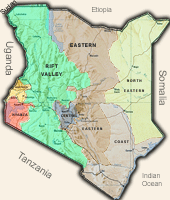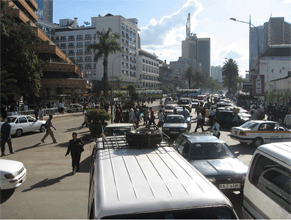Kenya
City Of Kenya
- Nairobi
- Mombasa
- Malindi
- Chogoria
- Embu
- Eldoret
- Garissa
- Homa Bay
- Isiolo
- Kajiado
- Kakamega
- Kendu Bay
- Kericho
- Kilifi
- Kissi
- Kisumu
- Kitale
- Kitui
- Kwale
- Lamu
- Limuru
- Lodwar
- Maralal
- Marsabit
- Meru
- Naivasha
- Nakuru
- Nanyuki
- Narok
- Nyahururu
- Nyeri
- Taveta
- Thika
National Parks
- Aberdare
- Amboseli
- Hell's Gate
- Ndere Island
- Kerio Valley
- Lake Nakuru
- Malka Mari
- Marsabit
- Meru
- Mombasa
- Mount Kenya
- Mount Longonot
- Nairobi
- Ruma
- Tsavo East
- Tsavo West
- Sibiloi
- Arabuko Sokoke Forest
- Victoria Lake
National Reserves
- Arawale
- Boni
- Dodori
- Tana River Primate
- Kakamega Forest
- Kiunga
- Kora
- Rahole
- Masai Mara
- Mpunguti
- Shimba Hills
- South Kitui
Marine Parks
Marine Reserves
Provinces of Kenya
Kenya
 For tourists Kenya is quintessential Africa. Seemingly endless blue skies over-reach red savannahs, where the big five animals still roam freely. Most visitors of course come here to go on safari, the Swahili word that has become synonymous with the country.
For tourists Kenya is quintessential Africa. Seemingly endless blue skies over-reach red savannahs, where the big five animals still roam freely. Most visitors of course come here to go on safari, the Swahili word that has become synonymous with the country.
Taking a safari during your stay is essential. The wildebeest migration in the Masai Mara is quite rightly proclaimed one of the animal kingdom's most impressive phenomena. The plains they sweep across are just one of a myriad of terrains found within the nation. Wetlands are home to crocodiles and hippos while the mineral rich lakes of the Rift Valley attract vast flocks of pink flamingos, which come for the small fish that thrive here.
However, it is a mistake to think of Kenya merely as one big safari park. There is a lot more to this fascinating country. It is known as the "Cradle of Civilisation" for it was here that the most ancient remains of early man were found in the 1920s, at the Hyrax Hill site near to Lake Nakuru by renowned anthropologist and archaeologist Louis Leakey. You can see many of these and other findings in the Kenyan National Museum in Nairobi.
You'll also find intriguing relics of history on and in the landscape. The Gedi Ruins are the most spectacular remains of the people who inhabited the coast - an enigmatic settlement of amazing sophistication yet unrecorded in any period literature. Malindi meanwhile is a reminder of the colonial influences on the country - the Portuguese were here for a couple of centuries and the shameful slave trade from the Kenyan coast under British jurisdiction is well documented.
Kenya isn't a tourist playground though - bush resorts and safaris are all well and good but in Nairobi and the other major cities the steady march of progress has come at a price - they aren't always the most pleasant locations to be a stranger. However these are more transitional than terminal problems; head outside the cities and you'll find the uncynical and hospitable nature of the people is once more asserted.
People come here to see the big five and enjoy the stunning natural landscape, and in truth there is no better reason for coming - but there are other lesser known attractions besides. The big city of Nairobi is interesting if not particularly alluring - and there is a surprising wealth of history hidden among the game parks and nature reserves.
Geografia
 With an area of 582,646 square kilometers, Kenya is one of the largest in the world. Bordered to the north with Ethiopia to the east with Somalia and the Indian Ocean, with Tanzania to the south and Uganda on the west.
With an area of 582,646 square kilometers, Kenya is one of the largest in the world. Bordered to the north with Ethiopia to the east with Somalia and the Indian Ocean, with Tanzania to the south and Uganda on the west.
- Mount Kenya (5199 m) - the second in Africa as height
- Mount Elgon – is an extinct volcano on the border with Uganda, has the famous Kitum cave where every night the herds of elephants gather and begin a procession into the depths of the mountain
- Mount Longonot (2,886 m) – is a dormant volcano and dominates the landscape for miles around
- Taita and Chyulu Hills – Chyulu hills are regarded as some of the youngest mountains in the world and in the Taita Hills is the rare Taita Falcone birds mentioned in Egyptian hieroglyphics.
- Shimba Hills – the National Reserve of Shimba Hills is located 48 km from the coast and is made up of pasture and rain forest
- The western plateau – has incredible views, particularly at the Nyaru's "World's End"
- The Loroghi Hills – has wooden valleys and the high plains are rich in birds and fauna.
- The Rift Valley – is a huge scar that crosses from north to south the territory, has dormant volcanoes and tectonic lakes, dominated by massive Mount Kenya has three peaks: Lenana (4,985 m), Nelion (5.188m) and Batian (5,199 m).
Mountains and hills of Kenya:
- Tana, Galana, Athi and Ewaso Ng'iro that flows into the Indian Ocean
- Mara and Nzoia that flows into the Victoria Lake
- Turkwel tha flow into the Turkana Lake
Rivers of Kenya:
The largest rivers that cross the Kenya are:- Turkana Lake – it's a huge inland sea, the largest lake of the desert in the world with a length of more than 250 km, and an area of 6405 square kilometers. Also known as the Jade Sea for its color of the waters.
- Victoria Lake – situated at the west border of the country, has only 3100 square kilometers in Kenya from a total of 68,100 square kilometers, is the source of the mighty Nile river.
- Naivasha Lake – nearly 13 square kilometers with an average depth of only 5 meters, mostly surrounded by acacia woods but also fertile soils for agriculture.
- Nakaru Lake – variables as size, increased from 5 to 30 km and is famous in the world for its thousands of pink flamingos and white and black rhinos.
- Elmenteita Lake – is a small soda lake, its shores are grazing area for zebras, gazelles and warthogs.
- Baringo Lake – with an area of 129 square kilometers, attracts pelicans, cormorants and eagle-fish but is also home to crocodiles.
- Bogoria Lake – with an area of 32 square kilometers, is still active as a volcano, is flanked by the west of geyser.
- Magadi Lake – with an area of 104 square kilometers, is completely surrounded by vast natural salt mines.
Lakes of Kenya:
- Lamu Island - the old medieval city in stone has portuguese, turkish and arabic influences. There are no vehicles on the island, the only public transportation is the donkey and the dhow.
- Manda Island – has the coasts wrapped by mangroves and beach with white sand, the ruins of Takwa has the houses built with limestone coral and mangrove wood.
- Pate Island – surrounded by mangroves is accessible only at high tide, there are many ruins including the most spectacular the fortress of Siyu.
- Mfangano Island – it is located on Victoria Lake, it's known for its ancient rock art, it seems to be about 2,000 years old and it was created by the Twa population.
- Rusinga Island – it is located on Victoria Lake, is a haven for many species of birds, many of them are unique in this area of the country.
- Wasini Island – it is located near the National Marine Park Kisite-Mpunguti, has cliffs of corals.
- Kiwayu Island – located in Kiung National Marine Reserve, its attraction is the snorkeling.
Kenya Islands:
Climate
The climate varies from one area to another, very hot and humid on the coast, pleasant in the Rift Valley and temperate and arid in the semi desert regions where the temperature varies from 40 º C during the day at 20 º C at night. There are two rainy seasons: the main rains (March to May) and small rains (from October to December).
Economy

The economy is based on the agriculture where is working nearly 70% of the population. In recent years there has also developed industry and tourism.
The agriculture is classified into two types: industrial (colonial) - with large plantations of coffee, tea, cotton, sugar cane, potatoes, tobacco, wheat, peanuts and sesame; indigenous (subsistence) based on cultures of corn, cassava, beans, sorghum and fruits.
Even cattle breeding is divided on the same criteria: the production of meat, milk, milk products, leather and wool is in the colonial holdings, while the indigenous breed the animals for their subsistence. The most valuable assets of the nomadic tribes are the cattle.
The industrial sector is based on food, beverages, tobacco, chemicals, petroleum, metals, textiles, leather, rubber, building materials (cement, clay, glass), the assembly of motor vehicles and pharmaceuticals.
The country's energy resources are scarce, much of the energy is imported, mainly the oil from Saudi Arabia and the United Arab Emirates. The energy comes mainly from hydroelectric plants, and only about 10% from coal and oil. The main hydro electric complex are located ion the River Tana (the Kindaruma dam) and on the Turkwel River drain by Turkestan Lake. However, hydroelectric power is still low and irregular, hindering the industrial production.
The mining industry is represented by the extraction of fluorite from the north of Nairobi, soda and salt from natural deposits from Magadi Lake, gold in Kakamega, lead and silver in Kinangoni.
The tourism sector has become increasingly important in Kenya, that makes biggest profits than exports of coffee and is the main source of foreign exchange. The country receives millions of tourists annually with a hotel capacity of about 9 million people.










